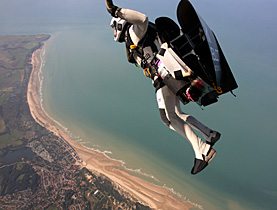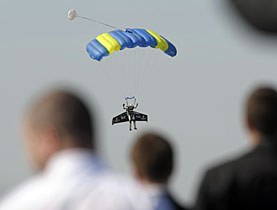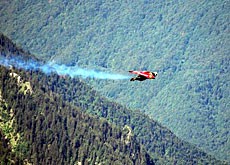“Fusionman” prepares flight over Grand Canyon

Fusionman – daredevil Swiss pilot Yves Rossy – talks to swissinfo about his new prototype wings, conquering the United States, and why the sky is the limit.
Rossy, 49, was at the Geneva Book Fair this week to promote his new book “Yves Rossy: homme volant” (flying man), detailing his birdman exploits over the past ten years.
The former fighter pilot hit the international headlines in September 2008 when he became the first person to fly solo across the English Channel using a single jet-propelled wing, retracing the route of French aviator Louis Blériot 99 years earlier.
Rocketing at an average speed of 200 kilometres per hour, Fusionman took less than ten minutes to complete the historic 35-kilometre crossing with his homemade device and then to parachute to the ground.
swissinfo: What you have been up to since your cross-Channel solo flight?
Yves Rossy: I haven’t flown very much, apart from returning to work as a commercial airline pilot [for Swiss]. I have done a lot of conferences, presentations and interviews, but it was the bad season for flying. I tried a couple of times, but the weather wasn’t very good.
We’ve been developing two prototype wings that I tested two weeks ago. Previous wings were gliders with jet engines attached. They were too wide, too heavy and too complicated to fly. The whole thing was too specialised and not reliable enough. The idea is to make something smaller, simpler and with higher performance: a smaller delta-shaped foldable wing with a lot more power.
I want to make a simple wing that I can share with others and put on someone else’s back so that we can do formation flying in the clouds.
I have a list of friends who are interested. They’re a bit scared, as it’s complicated, but when they see me they really want to do it. We’re developing the wing so it’s available for almost everyone. Anyone who is interested and prepared to spend some time in parachute training and who has some basic flying experience should give it a go.
swissinfo: What is your next big flying project?
Y.R.: I’ve been fascinated by the Grand Canyon for a long time now. A month ago we went there and found a spot for flying. I’d like to fly in the US to make my name over there.
At the Grand Canyon there are vertical cliffs over 1,000 metres high, so I can present what I do without taking risks. I will be 200 metres from spectators with 800 metres below me.
I’d like to go there as it’s well known and very beautiful. It’s also in an Indian reserve, so there is that symbolic side of things. I’d also like to fly elsewhere in the US, such as San Francisco, but I’d like to start with the Grand Canyon [in September/October this year].
swissinfo: Do you see yourself as a sort of modern-day Blériot?
Y.R.: A little bit. But in those days [flying pioneers] had to discover everything and they even gave their lives. Nowadays we know all about the laws of aerodynamics and we have material that allows us to have a plan B.
They didn’t have a plan B: either it worked or it didn’t. I feel a little bit of a pioneer, as I’m discovering an activity that doesn’t exist.
swissinfo: Why do you risk your life flying a homemade device that has taken years to develop and cost you hundreds of thousands of francs of your own money?
Y.R.: My motivation is to go where an idea takes me – I have an idea in my head and I wonder if it’s possible to realise.
This is creative: an idea, design, realisation and construction and then sharing it with lots of people. It’s very creative and for me very gratifying, much more than taking passengers from A to B in an Airbus.
I love the idea of doing something extraordinary, of going as far as possible and excelling, testing personal and technical limits. I like to make people dream – it’s very gratifying.
swissinfo: What does it feel like to fly with a jet-propelled wing on your back at 200km/h?
Y.R.: It’s always quite tense at the start, as there are lots of things to manage. I’m never really sure that the jets will start properly. You also have to be very precise when leaving the plane.
That is not really the fun moment, but once I’m out and I start flying, it’s pure pleasure and dreamlike. I am almost naked under my little wing with my flying suit. There is a feeling of being carried by this wing but also of being completely free thanks to my body movements.
I go in whatever direction I look. I arch my back and I go up, I lean forward and I go down, I turn my shoulders slightly and it turns. You simply look in the direction you want to go and it starts to turn, just with the head – it’s completely intuitive, amazing.
swissinfo: Apart from pilot skills, what physical and mental abilities do you need to fly a wing like yours?
Y.R.: You need quite good pilot skills but also considerable parachuting experience. You don’t need an amazing physical ability. The most demanding thing physically is leaving the plane and landing. The actual flying is quite gentle.
Mentally, you need to be able to weigh up all options, and when it’s a bit dangerous or if you need to be precise you shouldn’t tense up. And you shouldn’t be someone who takes risks.
Even if the wing goes out of control, you need to think hard and act fast.
swissinfo: Do you have a guardian angel?
Y.R.: Yes, and he has a lot of work with me! Someone or something accompanies me; I don’t know who or what exactly, but I call him the “Great Cui Cui” – the big bird. I’ve had a lot of luck up to now and I’m very grateful to my guardian angel and to life in general. I think he likes me up there and what I’m doing.
swissinfo-interview: Simon Bradley in Geneva
Yves Rossy, aka Fusionman, was born on August 27, 1959 in Neuchâtel, Switzerland.
He has worked for the past ten years as a commercial pilot for the airline company, Swiss. Prior to that, he worked for 15 years as a fighter pilot for the Swiss Air Force.
An accomplished sportsman, his past and present hobbies include surfing, water-skiing, wakeboarding, parachuting, aerobatics, motorbike riding, rafting and hang-gliding.
He has long been involved in flying adventures. He is a keen sky surfer – performing aerial stunts on a board after freefalling from a plane – and was the first to sky surf from a hot air balloon.
Another Guinness record comes from being the first person to be transported between two small planes while holding onto handles on the wingtips of each plane.
Rossy zoomed into the record books on June 24, 2004 by becoming the first person to fly horizontally for four minutes with a jet-propelled wing strapped to his back.
On September 26, 2008 Rossy became the first person to fly solo across the English Channel using a single jet-propelled wing, retracing the route of French aviator Louis Blériot.
Rossy’s transformation from human to jet-man involves putting on a Formula-1 fireproof suit, three parachutes, two for Rossy and one for his wing, a helmet that beeps a warning when he goes too low and his homemade three-metre-wide carbon wing, which is strapped to his back and powered by four mini jets. His invention weighs about 55kg with fuel.
The wing, which he conceived, built and fine tuned himself over eight years, has no steering capability so Rossy had to control his movement using his head, shoulders and arms. The only instrument is the fuel throttle.

In compliance with the JTI standards
More: SWI swissinfo.ch certified by the Journalism Trust Initiative












You can find an overview of ongoing debates with our journalists here . Please join us!
If you want to start a conversation about a topic raised in this article or want to report factual errors, email us at english@swissinfo.ch.